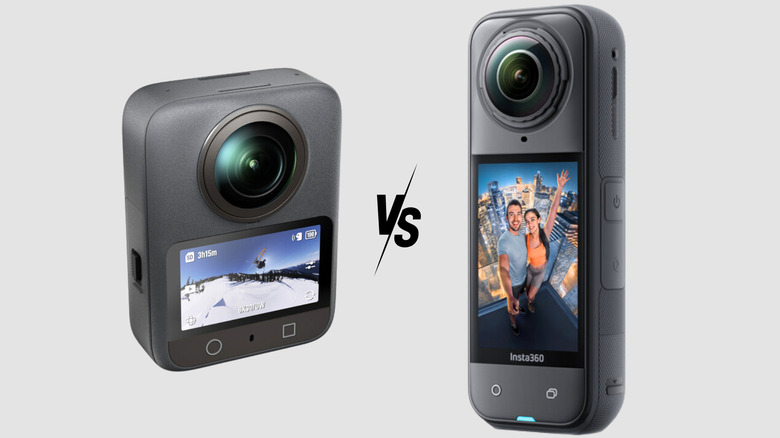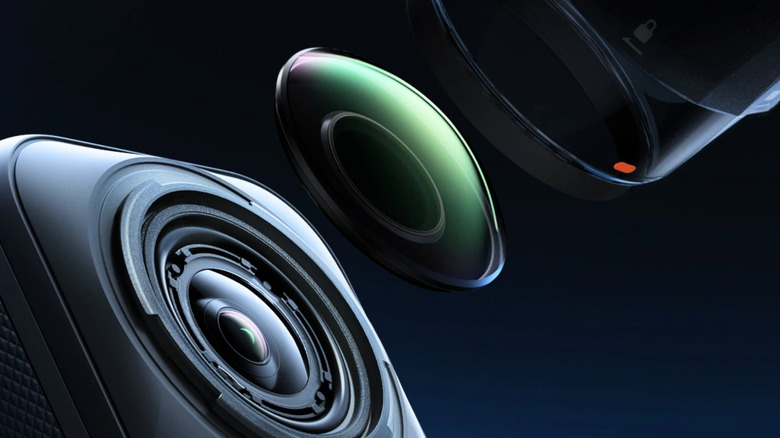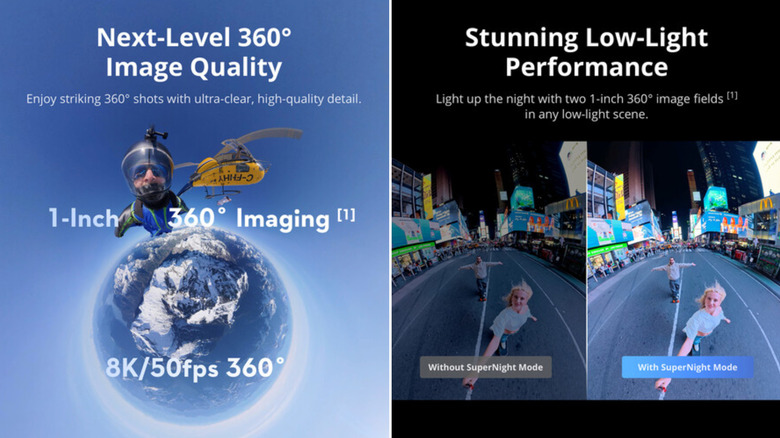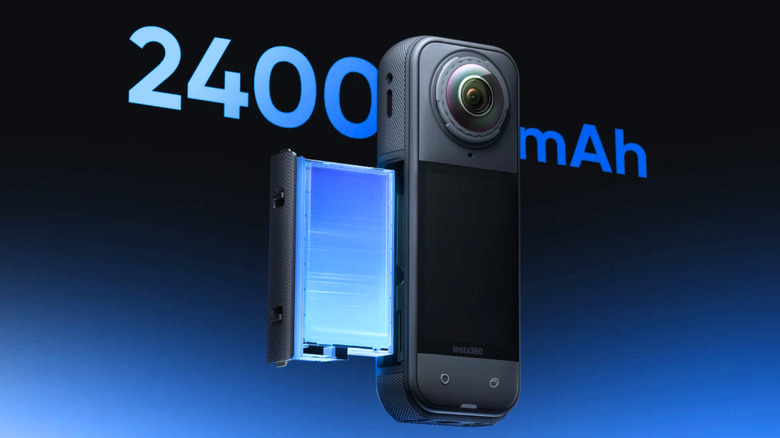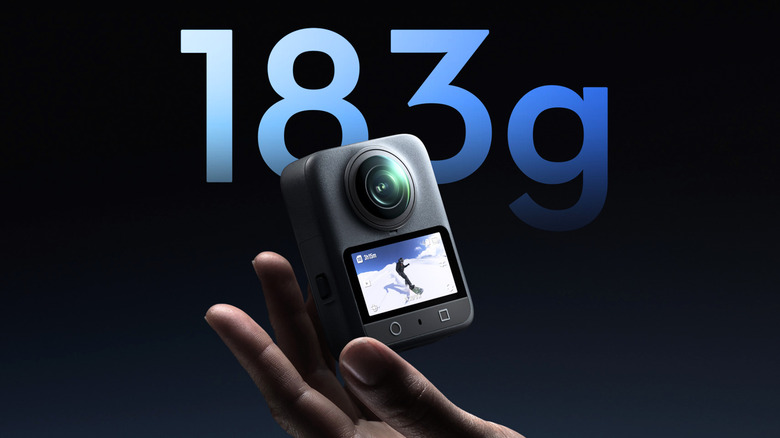DJI's Osmo 360 Camera Is Here, But How Does It Compare To The Popular Insta360?
We may receive a commission on purchases made from links.
With the Osmo 360, DJI has entered into the 360-degree camera market; a category that has picked up some heat in recent years, thanks to travel vloggers and content creators. For its first panoramic action camera, DJI seems to have gone all-in: The Osmo 360 offers dual one-inch sensors, provides extended 8K video recording, and can shoot crisp 4K video at 120 fps.
While the company has an extensive lineup of drones, gimbals, and action cameras, it has stayed away from the panoramic camera space long enough for Insta360 to gain popularity among U.S. buyers. Insta360's latest release, the Insta360 X5, debuted in April 2025 with features like dual 1/1.28-inch sensors, support for 8K video, and improved water-resistance.
Like the Insta360 X5, the DJI Osmo 360's standard combo costs $549.99, but the product isn't available on the company's official website. Instead, it is available via third-party retailers like Amazon and B&H. Assuming that you're willing to overlook that, here's a detailed comparison between the devices.
Sensors, shutter speed, and image quality
Right off the bat, the DJI Osmo 360 features two 1/1.1-inch CMOS sensors (marketed as square HDR sensors), with an aperture of f/1.9, a photographic shutter range of 1/8000 to 30 seconds, and an ISO range of 100 to 51,200. What's more is that the device offers 13.5 stops of dynamic range, allowing it to preserve higher detail in high-contrast scenes.
In comparison, the Insta360 X5 features slightly smaller 1/1.28-inch CMOS sensors with an f/2.0 aperture. While its shutter speed is better suited for long-exposure shots (1/8000 to 120 seconds), the ISO range of 100 to 6,400 is significantly lower. Although the company doesn't specify the dynamic range stops, it provides software-based HDR compensation.
Due to its larger sensor size, the Osmo 360 provides an effective photo resolution of 120MP in panoramic mode and 30.72MP in single-lens photo mode, whereas the X5 captures in 72MP and 18MP in both modes, respectively (similar to the Insta360 X4). Despite being a bit older, the Insta360 can capture images in RAW (DNG) format, which is crucial for professionals. The Osmo 360, on the other hand, only supports JPEG for photos, which could be a letdown for professionals or content creators. Although, DJI could add it later with a firmware update.
Video resolution, frame rate, and format
Both action cameras can record 8K 360-degree videos, but the Osmo 360 has an edge with 8K at 50 fps, compared to the X5's 8K at 30 fps. The DJI also supports 6K at 60 fps, while its competitor maxes out at 5.7K at 60 fps. However, when it comes to 4K recording, the X5 can shoot in 120 fps; as opposed to 100 fps on the Osmo, resulting in better slow-motion videos. While both cameras record in their proprietary formats (OSV for DJI, and INSP for Insta360), you can easily export videos in MP4.
Moving on to the single-lens mode, DJI comes out on top with a higher resolution: 5K at 60 fps, compared to the X5's 4K at 60 fps. In the ultrawide mode, you can push the Osmo 360 all the way to 4K at 120 fps, but the Insta360 remains limited to 4K at 30 fps. Both cameras offer horizon-levelling electronic stabilization: Called RockSteady 3.0 on the DJI (also offered on the Osmo Action series) and FlowState Stabilization on the Insta360, along with wind noise reduction.
For low-light video, both cameras offer dedicated night modes: DJI's SuperNight and Insta360's PureVideo. While both modes let you shoot 8K videos at 30 fps, DJI goes a step further by providing 6K at 30 fps, whereas its competitor remains capped at 5.7K. The Osmo 360 has four built-in microphones, while the X5 has two, though both support first-party external microphones.
Storage and battery life
Both the DJI Osmo 360 and the Insta360 X5 support microSD cards of up to 1TB (with at least 30 MB/s write speed). However, the Osmo 360 comes with 128GB of built-in storage, which acts as a safety net in case you forget to carry a memory card.
Talking about batteries, the DJI Osmo 360 features a 1,950 mAh battery, rated for up to 100 minutes of continuous 8K (30 fps) recording, or up to 190 minutes at 6K (24 fps) in Endurance mode. DJI also sells a $99.99 Battery Extension Rod, which increases the 8K recording time to 180 minutes. It's worth pointing out that the device uses the same battery as the Action 5 Pro.
In contrast, the Insta360 X5 gets a bigger 2,400 mAh battery that lasts just under two hours while recording in 8K (30 fps) and 208 minutes in 5.7K (24 fps, in Endurance Mode) with the latest v1.3.0 firmware. With fast charging, the battery reaches 80% in about 20 minutes, and 100% in around 35 minutes (with a PD3.0, PPS 30W USB-C charger). The company also sells a $44.99 X5 Ultra Battery, which increases the 5.7K recording time to 235 minutes. As always, these numbers are based on testing conducted in controlled conditions, so take these numbers with a pinch of salt versus real life conditions.
Water resistance, software, and price
The Osmo 360 is noticeably smaller and 17 grams lighter than the X5, making it relatively easier to slip it into a pocket or carry around. Both cameras use a plastic body, but the X5 has a clear durability edge: Replaceable lenses sold as part of the $29.99 Lens Kit. A magnetic mounting system, however, is common on both devices. Even though both devices have an IP68 rating, you can use the Insta360 X5 at depths of up to 15 meters, which is five meters deeper than what the Osmo 360 is rated to survive. With the $99.99 Invisible Dive Case, the X5 can even go to 60 meters underwater, making it more suitable for divers.
With the Osmo 360, you get companion apps like DJI Mimo (mobile), which offers features like Intelligence Tracking, GyroFrame, and Editing Assistant. Then there's the Studio (desktop) app, which enables advanced manual editing. In contrast, the Insta360 mobile app is more beginner-friendly, as it offers a template-based AI video editor (useful for beginners), and additional features like AdaptiveTone, InstaFrame, and Shot Lab.
Finally, let's talk about the pricing: The Osmo 360 Standard Combo retails for $549.99 via Amazon or B&H Photo. The Insta360 X5 Standard Bundle, meanwhile, is currently discounted to $519.99 on the company's official website.
